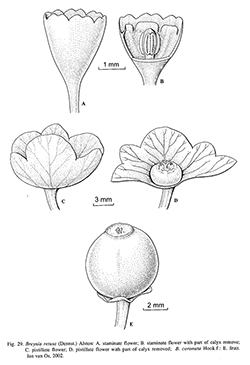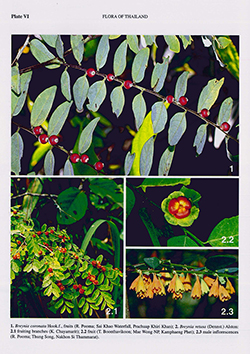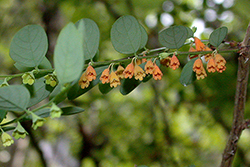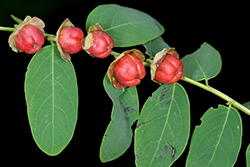e-Flora of Thailand
Volume 8 > Part 1 > Year 2005 > Page 139 > Euphorbiaceae > Breynia
6. Breynia retusa (Dennst.) Alstonwfo-0000414213
Ann. Roy. Bot. Gard. (Peradeniya) 11: 204. 1929; in Trimen, Handb. Fl. Ceylon 6, Suppl.: 261. 1931; Airy Shaw, Kew Bull. 26: 227. 1972; Li in Wu & Li, Fl. Reipubl. Popularis Sin. 44(1): 181.pl. 54 figs. 1.4. 1994: Chakrab. & M.G.Gangop., J. Econ. Tax. Bot. 20: 505, fig. 3. 1996; Welzen & Esser in Welzen et al., Thai Forest Bull., Bot. 28: 76. 2000.— Phyllanthus retusus Dennst., Schlüss. Hort. Malab. 1. Register: 15; 2. Register: 24; 3. Register: 31. 1818.— Melanthesa retusa (Dennst.) Kostel., Allg. Med.-Pharm. Fl. 5: 1771. 1836. Fig. 29: A-D; Plate IV: 2.
Accepted Name : This is currently accepted.
Synonyms & Citations :
Description : Shrub to treelet up to 5 m high, somewhat scandent; branches turning brown soon, glabrous. Stipules 1.2–2 by 0.6–0.7 mm. Leaves: petiole 0.6–2.5 mm long; blade oblong-elliptic, 1.2–3.6 by 0.6–2 cm, length/width ratio 1.8–2.5, membranous, base obtuse, asymmetric, margin flat, apex round to indistinctly acute, mucronulate, dark green above, very light pale green beneath; nerves 5–7 until apex, distinctly glaucous beneath with veinlets indistinct. Staminate flowers 1.8–3.4 mm in diam.; pedicel 1.5–5 mm-long; calyx pale green to orange, 3–5 by 1.8–3.4 mm, relatively thin, straight; androphore 1.1–1.6 mm high, anthers 0.8–1 mm long. Pistillate flowers solitary; pedicel 1.2–3 mm long; calyx initially 1.2–1.5 mm long, soon accrescent and 2.3–7.8 mm long, membranous, greenish to pinkish/pale red; ovary 0.5–1.2 by 0.8–1.2 mm; style seldom absent, 0.2–0.8 mm long; stigmas 0.5–0.6 mm long, apically split for 0.2–0.3 mm, spreading. Fruits solitary; pedicel 2–6 mm long; calyx distinctly accrescent, 6–17 mm in diam. and larger than the fruit, membranous, with free lobes 1.5–3 mm long; capsule 4.5–7 by 5–8 mm, turning orange to red to purple, drying reddish-brown, apically ± smooth or with a shallow crown. Seeds 3.6–4 by 2.2–2.8 by 2.2–2.8 mm, yellow to red.
Thailand : NORTHERN: Mae Hong Son, Chiang Mai, Chiang Rai, Phayao, Nan, Lamphun, Lampang, Phrae, Tak, Phitsanulok, Kamphaeng Phet, Nakhon Sawan; NORTH-EASTERN: Loei, Nong Khai; EASTERN: Chaiyaphuin, Si Sa Ket; SOUTH-WESTERN: Uthai Thani, Kanchanaburi, Phetchaburi, Prachuap Khiri Khan; CENTRAL: Saraburi, Nakhon Nayok; SOUTH EASTERN: Chon Buri, Chanthaburi, Trat; PENINSULAR: Ranong, Phangnga, Phuket, Nakhon Si Thammarat, Phatthalung, Trang, Satun, Songkhla.
Distribution : India (type), Sri Lanka, Bhutan, Nepal, Myanmar, SW China, Indochina, Peninsular Malaysia.
Ecology : In oak-pine forests, dry dipterocarp forests, secondary thickets and forests, also seasonally burned, tea and pine plantations, degraded dry to wet and bamboo-rich evergreen forests, seasonal mixed evergreen/deciduous forests, on rocky places and slopes, along rivers; on alluvial, sandy, shale, phyllite, limestone, granite or sandstone bedrock; 100–1,360 m alt.
Vernacular : Khram nam (ครามน้ำ)(Shan-Mae Hong Son); khao-chan (ขาวจัน), na kho-thi (นะฆอที)(Karen-Mae Hong Son); phong (พอง), ra ngap (ระงับ)(Southeastern); kang pla khao (ก้างปลาขาว)(Peninsular).
Notes: Breynia angustifolia and B. retusa are certainly synonymous. Airy Shaw (1972) recognised both species, because there is indeed some variation within Thailand. In Chiang Mai, the fruits are slightly smaller and the calyx somewhat more enlarging than elsewhere. There are however no names available to describe this variability.




